Between roughly 1300 – 1850, the world experienced the ‘Little Ice Age’, where there was significant cooling in global temperatures. Temperatures and the effects varied from region to region and year to year, but there were 3 significant intervals of particular cold, c. 1650, c. 1770, and c. 1850. In England, this resulted in particularly cold winters which caused many hardships for its citizens. However, between 1400 and 1835, this also resulted in at least 24 winters where the River Thames froze over which led to merriment for all.
During this period, there were numerous factors which contributed to the freezing of the Thames beyond just the lower temperatures. The Thames was wider, as it had not yet been embanked, meaning it was both shallower and flowed slower. Moreover, old London Bridge was supported with closely spaced piers and timber casings which made for narrow arches for the water to pass through. This meant that when chunks of ice formed, they were easily trapped between the arches, both creating a dam which pooled the water, and preventing the salty sea water from travelling up the river.

Thames Frost Fair, 1683–84, by Thomas Wyke.
The sixteenth century was the first period where there was frequent freezing of the Thames, with up to 5 years where the Thames froze or ‘more-or-less’ froze over. When the river froze, the men who made money ferrying people over in boats had their livelihood taken away, and merchants and other tradesmen had restricted access to goods and customers. It was therefore inevitable that when the ice was thick enough to cross by foot, people would take to it. The ferry men would charge people to escort them across the ice, and tradesmen would carry their goods across. When the ice was thick for an extended period of time, however, was when the real fun began.
Initially the river was mostly used for travel or small-scale fun. In 1536, Henry VIII sleighed along the river from central London to Greenwich, whilst in 1564 his daughter Elizabeth I used the frozen river for archery whilst children would play football. But in the seventeenth century, as the cold hit its peak, the river froze over more often and for longer. The first recorded frost fair occurred in 1608, but one of the most famous fairs was the one of the winter of 1683-84.
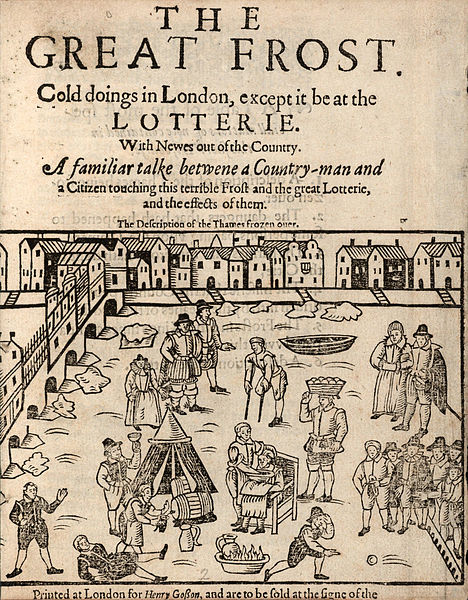
An account of the first known Frost Fair. Printed at London For Henry Gosson, 1608.
People flocked to the ice to set up temporary shops. Food stalls were set up to feed customers, and fun and games would take place. People roasted oxen which could feed up to 800 people per animal, and the ice was safely thick enough for shop keeps to light fires in their tents to keep themselves warm. John Evelyn, a famous diarist, describes the fair of 1683-4 thusly:
“Coaches plied from Westminster to the Temple, and from several other stairs too and fro, as in the streets; sleds, sliding with skeetes, a bull-baiting, horse and coach races, puppet plays and interludes, cooks, tipling and other lewd places, so that it seemed to be a bacchanalian triumph, or carnival on the water”
It certainly seemed full of excitement! This was not a small-scale festivity of local children playing on the ice, but most of the city was involved. Even the king, Charles II, joined in; he bought a souvenir card which was being sold by the printer Croom for sixpence. Croom would print the customer’s name, the date, and the fact that the card was being printed on the Thames. Charles and his wife, Catherine of Braganza, also ate part of an ox that was being roasted whole on the river near Whitehall.
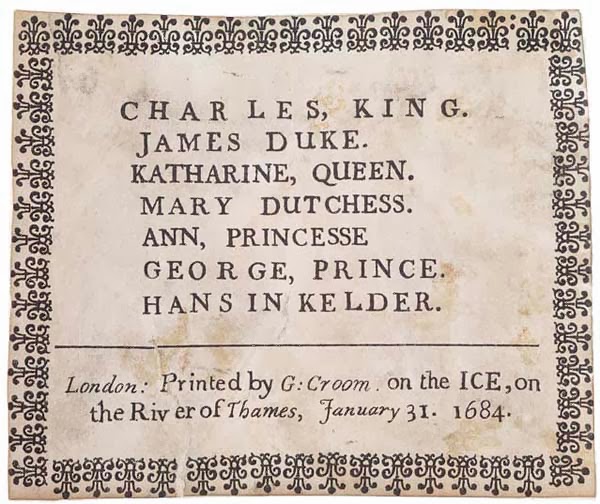
Charles’ souvenir frost fair card. Held at British Museum.
The frost of this year was the worst ever recorded in England, with the Thames being completely frozen for 2 months, reaching a thickness of 11 inches. The ice was so bad that even parts of the sea froze over – solid ice was reported extending for miles off the coasts of the southern North Sea (England, France and the Low Countries). This meant that this particular frost fair lasted far longer than most, and the Thames effectively became another street in London. Another eye-witness records similar sights to Evelyn:
“On the 20th of December, 1688 [misprint for 1683], a very violent frost began, which lasted to the 6th of February, in so great extremity, that the pools were frozen 18 inches thick at least, and the Thames was so frozen that a great street from the Temple to Southwark was built with shops, and all manner of things sold. Hackney coaches plied there as in the streets. There were also bull-baiting, and a great many shows and tricks to be seen. This day the frost broke up. In the morning I saw a coach and six horses driven from Whitehall almost to the bridge (London Bridge) yet by three o’clock that day, February the 6th, next to Southwark the ice was gone, so as boats did row to and fro, and the next day all the frost was gone.” [quote found here]

Abraham Hondius, ‘The Frozen Thames, 1677’
 ‘A Frost Fair on the Thames at Temple Stairs’, 1684, Abraham Hondius.
‘A Frost Fair on the Thames at Temple Stairs’, 1684, Abraham Hondius.
In the eighteenth century, there were some tragedies at some of the frost fairs. During the fair of 1739, a large piece of ice gave way and tents, business, and people were swept away. In January 1789, a ship had been anchored to a riverside pub in Rotherhithe overnight, but quick thawing of the ice dragged the ship about. As the anchor was deposited in the cellar of the pub, and a cable fastened around a beam in the house, the veering of the ship pulled the house down, killing 5 people sleeping inside.

Enjoying this blog post? Buy me a hot chocolate!
Consider donating the cost of a hot chocolate to me, so I can continue to write and run Just History Posts.
£3.50
The last great frost fair occurred in 1814, lasting from 1st – 5th February. The UK had suffered a particularly cold January; January 1814 saw average temperatures of -2.9°C, compared to average UK temperatures of 3.9 °C in January 2017. Despite the short-lived nature of this particular frost fair, it was organised swiftly and had all manner of entertainment. A main ‘street’ called The City Road was set up, where merchants would sell trinkets and souvenirs. Children’s swings – similar to the banana boats of today’s fairs – were erected, and gambling dens set up for the adults. Just as printers during the fair of 1683-4 gave out souvenir cards, so printers of 1814 set up shop on the ice. Nearly a dozen heavy printing presses were erected on the Thames, with poems being printed for customers to commemorate the event. A printer named George Davis even typed, printed, and published a 124-page book called Frostiana; or a History of the River Thames in a Frozen State from his stall on the Thames. The hustle, bustle, and fun of this last frost fair is recorded by one witness:
“At every glance, there was a novelty of some kind or other. Gaming was carried on in all its branches. Many of the itinerant admirers of the profits gained by E O Tables, Rouge et Noir, Te-totum, wheel of fortune, the garter, were industrious in their avocations, and some of their customers left the lures without a penny to pay the passage over a plank to the shore. Skittles was played by several parties, and the drinking tents were filled by females and their companions, dancing reels to the sound of fiddles, while others sat round large fires, drinking rum, grog, and other spirits. Tea, coffee, aud eatables, were provided in abundance, and passengers were invited to eat by way of recording their visit. Several tradesmen, who at other times were deemed respectable, attended with their wares, and sold books, toys, and trinkets of almost every description.” [quote from Historic UK]
There were even reports of an elephant being led across the river below Blackfriars Bridge!
 ‘The Frost Fair of 1814′, by Luke Clenell.
‘The Frost Fair of 1814′, by Luke Clenell.
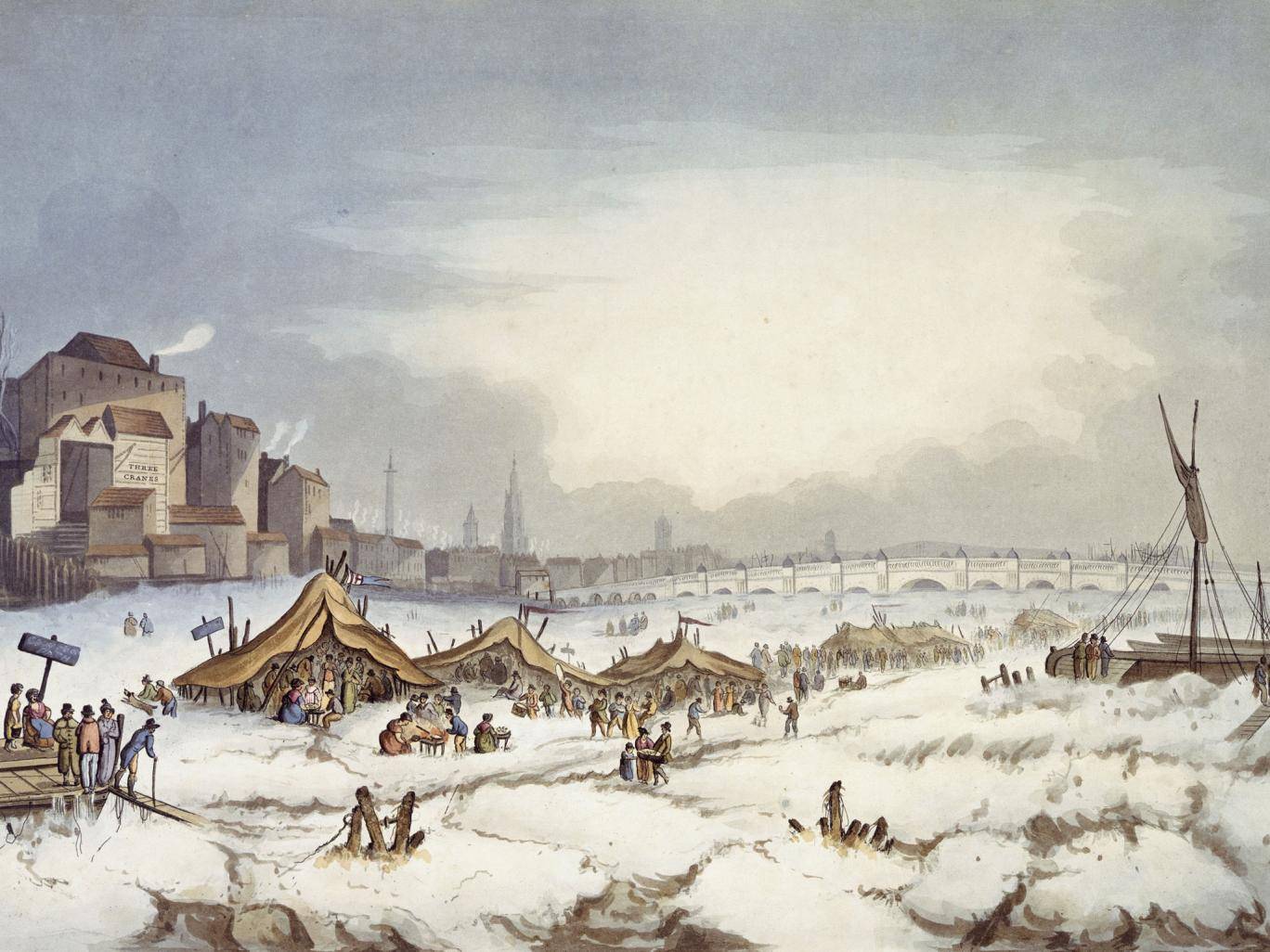 Colour aquatint showing the frost fair on the Thames published 18th February 1814. Museum of London.
Colour aquatint showing the frost fair on the Thames published 18th February 1814. Museum of London.
However, the 1814 frost fair was to be the last the Thames saw. Temperatures began to warm as the industrial era took over, and old London Bridge was replaced with a new one in 1831 which had fewer arches, which allowed the water to flow better and allowed sea water which is more difficult to freeze to flow back up into the river. When the Embankment was constructed, the river was narrowed and thus flowed faster, reducing the chance of freezing further.
We may not have these frost fairs any more, but whenever the country snows over you will still see people making piles of snow and tobogganing down city streets. Something about snow manages to bring out our communal spirit and joint fun (when not grumbling about the whole country being ground to a halt by a few cm of snow…). I have to say, though, I would certainly have liked to have been able to see one of the Thames frost fairs in all of its glory.
Previous Blog Post: Why Are There So Many Snails In Medieval Manuscripts?
Previous in Seasonal: Gunpowder, Treason, and Plot: Who was Guy Fawkes?
List of Blog Posts: here Blog Homepage: here
Buy my books via the pictures below! Or why not check out our shop?

Follow us:
Read more:
http://www.historic-uk.com/HistoryUK/HistoryofEngland/The-Thames-Frost-Fairs/
http://www.bbc.co.uk/news/magazine-25862141
https://www.thehistorypress.co.uk/articles/the-last-thames-frost-fair/

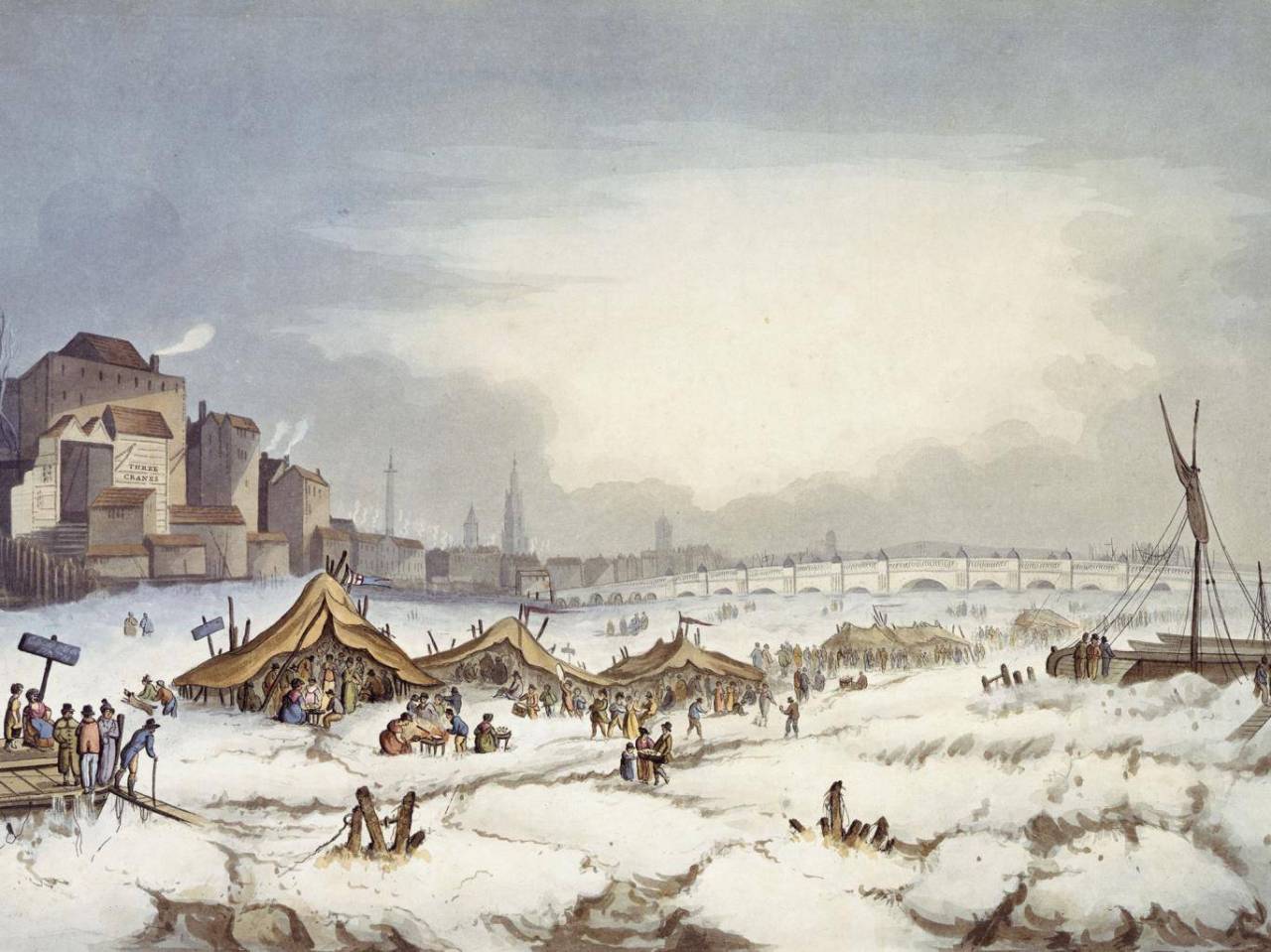

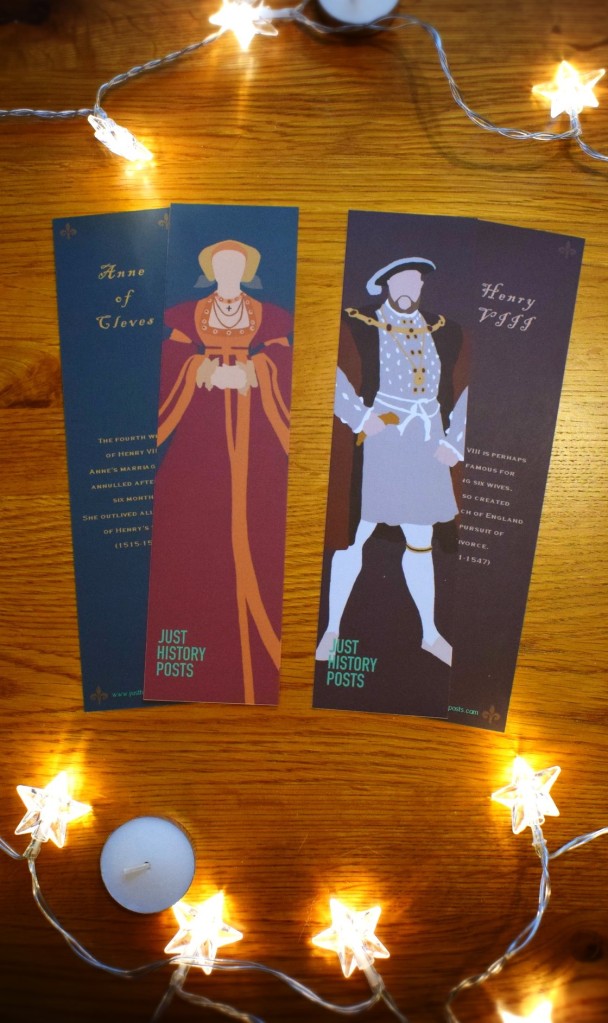


So crazy to imagine! The first I heard of this was in Virigina Woolf’s ‘Orlando’–there are some scenes in the Elizabethan chapters that take place on the ice. Worth reading the fictional account if you haven’t before!
LikeLiked by 1 person
It really is! I struggle to picture it, it must have been quite a sight. Oh lovely thanks for the recommendation!
LikeLiked by 1 person
What I find interesting is the desire of people to set up businesses on the ice. Food stalls and the like I can undersrand.. but setting up a printing press!! Great review.
LikeLiked by 1 person
I know! It seems such a strange thing to do! But must have been a lot of fun to visit
LikeLiked by 1 person
Reblogged this on Lenora's Culture Center and Foray into History.
LikeLike
Nicely researched, nicely told. It would certainly have been something to see – 11 inches?! Wow!
LikeLike
It really would have. And yes, you can’t imagine freezing that thick in England today!
LikeLike